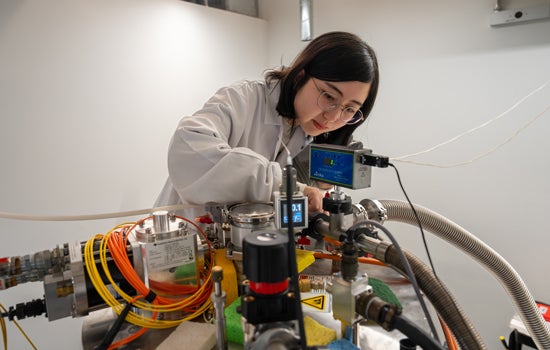Building a World of Women in Science
Each year, talented students from Japan come to Rice to work in labs, build friendships and gain confidence in pursuing a career in STEM.

Fall 2025
By Lynn Gosnell
In February, Rice’s Smalley-Curl Institute welcomed 10 Japanese students to campus to participate in the 2024–25 TOMODACHI-Dow Women’s STEM Leadership and Research Program — a five-week internship that thoughtfully combines academic rigor, mentorship and cultural exchanges.
Leading the internship program is physicist Junichiro Kono, the director of the Smalley-Curl Institute and a renowned researcher in light-matter interactions and quantum materials. Rice’s TOMODACHI-Dow internship is the latest in a string of award-winning international educational programs founded or guided by Kono. The program’s mission is to serve as a catalyst for female Japanese students to advance their commitment to science and engineering research and engagement with the U.S. with an eye toward reducing the gender gap in STEM in Japan.
“We go through a rigorous application process to select 10 students to attend,” explains Kono, who serves as TOMODACHI’s research director. TOMODACHI-Dow participants also have the opportunity to collaborate and interact with 10 Taiwanese students pursuing STEM degrees who visit Rice at the same time through a similar program called MACHI, fostering a rich cross-cultural experience.
The program’s mission is to serve as a catalyst for female Japanese students to advance their commitment to science and engineering research and engagement with the U.S. with an eye toward reducing the gender gap in STEM in Japan.
Long before they stepped on campus, the newest cohort of TOMODACHI-Dow and MACHI interns were matched with faculty researchers and their lab groups. These included faculty mentors in physics, bioengineering, computer science, biosciences and materials science.
Sae “Rylie” Endo, a rising senior at Keio University in Yokohama, studies applied physics and has already set her sights on applying for a doctoral program in the U.S. At Rice, she joined Kono’s lab, working directly with Dason Kim ’25 to research light-matter interactions using terahertz time-domain spectroscopy.
“I really got to know how the lab works, not just about research or how we use these tools, but also how we do both small- and big-group meetings and how to use Slack to communicate,” Endo explains.
TOMODACHI-Dow education director Naoko Ozaki, a multilingual lecturer in Japanese at Rice, developed a full complement of lesson plans designed to help prepare the students for life at Rice. Assignments included practicing speaking and writing in English in situations like talking with a professor or with another student, for example.
“We also asked 20 female students in STEM to work as peers,” says Ozaki, who enjoyed taking the students to attend basketball games or have meals in Lovett College, where she is an RA. “I hope that what we did before and throughout their stay in Houston led to building a strong relationship among the participants,” she says.
A poster competition closed out the internships. Despite never having created a poster or presented her research in competition, Endo took home the top prize. This summer, she returned to Rice and worked with Kim to further advance their research.
“It was very good that I got to know [the students],” Endo says, “because some of them were in the same field as me and all of them are very motivated.”
The TOMODACHI Initiative is a public-private partnership between the U.S.-Japan Council and the U.S. Embassy in Tokyo, with support from the Government of Japan. The program is funded by Dow Chemical Japan Limited.
